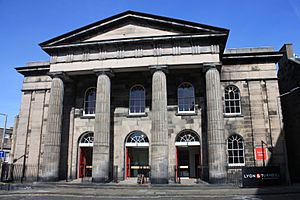Archibald Elliot facts for kids
Quick facts for kids
Archibald Elliot
|
|
|---|---|
| Born | August 1761 |
| Died | 16 June 1823 |
| Occupation | Architect |
| Buildings | Stobo Castle |
Archibald Elliot (born August 1761 – died June 1823) was a famous Scottish architect. He lived and worked in Edinburgh. Archibald Elliot had a special way of designing buildings. His style often included square shapes, hidden roofs, and walls that looked like castle battlements. He also liked to add square towers at the corners of his buildings. Many of the buildings he designed are no longer standing today.
Contents
The Life of Archibald Elliot
Early Life and Training
Archibald Elliot was born in a place called Ancrum in Roxburghshire, Scotland. His father was a carrier, which meant he transported goods. Archibald first trained to be a joiner, someone who builds things with wood. Later, he started designing cabinets. He even worked in London for a while. After that, he trained to become an architect before returning to Scotland to work in Edinburgh.
Family and Work
Archibald Elliot ran his architecture business with his younger brother, James Elliot. They worked together from around 1800. Sadly, James passed away in 1810. After that, Archibald ran the company by himself. Later, Archibald's son, also named Archibald Elliot, took over the business.
Archibald Elliot helped design many important buildings and streets in Edinburgh. These include St Paul's and St George's Church, Rutland Square, the Regent Bridge, and Waterloo Place. He also worked on many large country houses across Scotland. Some of these include Blair Castle and Taymouth Castle in Perthshire, Loudoun Castle in Ayrshire, and Stobo Castle in Peeblesshire.
Where He is Buried
Archibald Elliot is buried in New Calton Cemetery in Edinburgh. This cemetery is close to some of the areas he helped design, like Waterloo Place. His son, William Elliot, is buried with him.
Key Buildings Designed by Archibald Elliot
Archibald Elliot designed many notable buildings during his career. Here are some of his most important works:
- Loudoun Castle (1804): He completely rebuilt this castle around an older tower. Much of it has since been taken down.
- Stobo Castle (1805)
- Taymouth Castle (1806)
- Guildhall, Dunfermline (1807)
- General Register House (1813): He redesigned parts of this building to add a basement level.
- Calton Prison (1815): This prison was later taken down in 1930.
- Midlothian County Hall, Edinburgh (1816): This building has also been taken down.
- Waterloo Monument, Peniel Heugh (1817)
- St Paul's Chapel, York Place, Edinburgh (1818)
- 35 St Andrew Square, Edinburgh (1819): This building became the head office for the Royal Bank of Scotland.
- Rutland Square and Rutland Street, Edinburgh (1819–21)
- St George's Church, Paisley (1819): He designed this with William Reid.
- Broughton McDonald Church, Broughton Place, Edinburgh (1820)
- Edmonstone House, south of Edinburgh (1821): Most of this house has been taken down.
- Blair Atholl Church (1823)
- Jedburgh Castle Jail (1823)
- St Marks Episcopal Church, Portobello (1823): His son finished this church after Archibald passed away.
Images for kids






